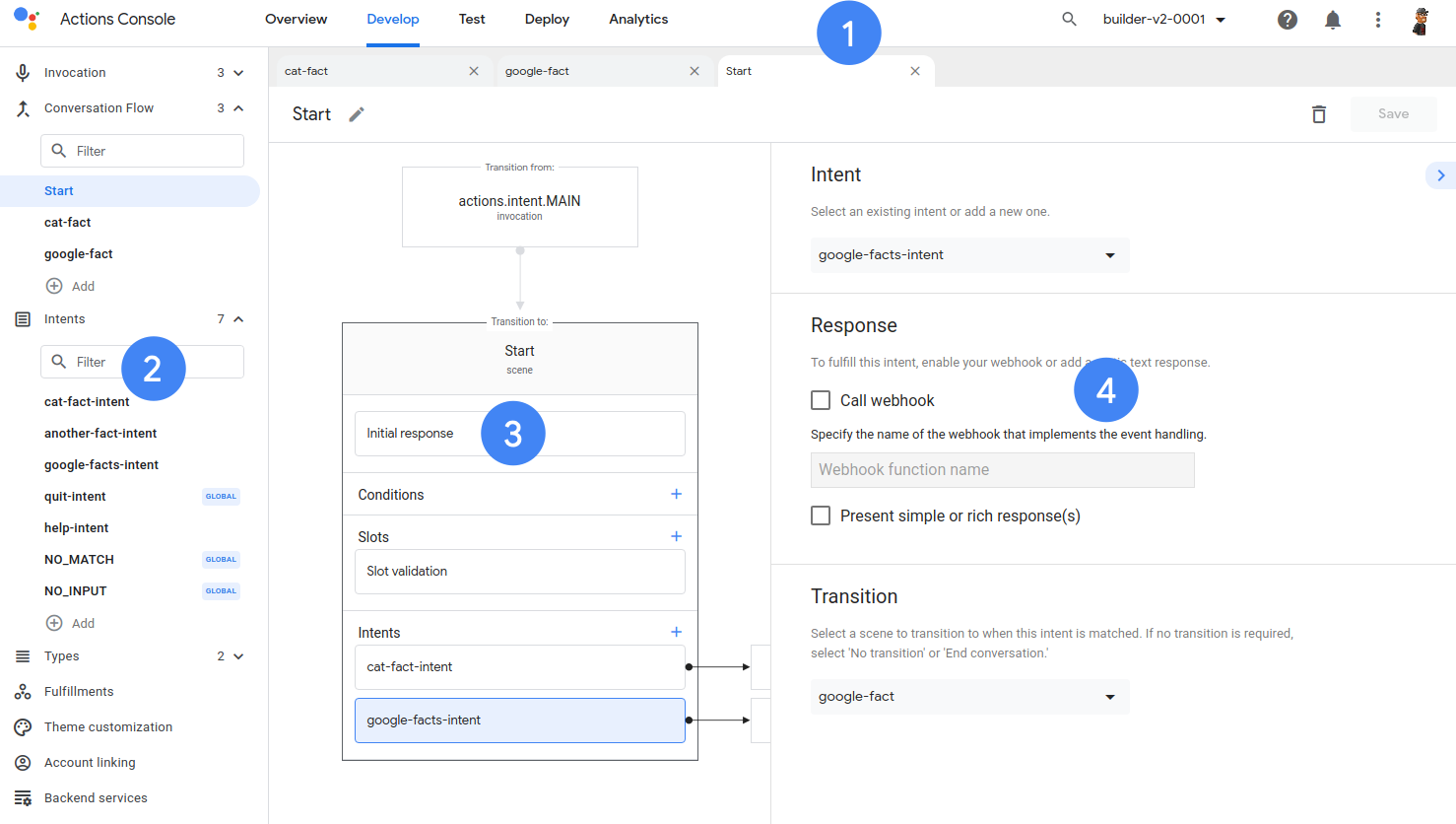Aby tworzyć działania konwersacyjne, musisz utworzyć i wdrożyć te komponenty:
- Projekt działań – logiczny kontener wszystkich działań konwersacyjnych, usług internetowych i aplikacji internetowych. Określa też ustawienia i zasoby projektu, które opisują sposób wdrażania projektu w Actions on Google.
- Model wywołania – określa, w jaki sposób użytkownicy mogą odkrywać i uruchamiać działania w projekcie. Model wywołania tworzysz za pomocą intencji i typów.
- Model konwersacji – określa, co użytkownicy mogą powiedzieć Twoim działaniom i jak działania odpowiadają użytkownikom. Model konwersacyjny tworzysz za pomocą intencji, typów, scen i promptów.
- Webhooki – działania mogą wywoływać webhooki, aby przekazywać dodatkową logikę do usług realizacji, np. generowanie promptów, sprawdzanie poprawności danych itp.
- Interactive Canvas – zamiast wysyłać proste odpowiedzi tekstowe lub karty multimedialne i obrazy możesz dostarczać interaktywną aplikację internetową na pełnym ekranie opartą na HTML, CSS i JavaScript.
W sekcjach poniżej znajdziesz opis narzędzi, których będziesz używać do tworzenia działań.
Działania
Interfejs Actions API to zestaw narzędzi dla programistów do tworzenia działań dla Asystenta Google. Obejmuje on te funkcje:
Otwarta reprezentacja projektu w Actions oparta na plikach – twórz modele wywoływania i rozmowy za pomocą intencji, typów, scen i promptów. Możesz edytować projekty działań w ulubionym edytorze tekstu, sprawdzać je w systemie kontroli wersji, tworzyć zautomatyzowane procesy i wykonywać inne czynności.
Interfejs wiersza poleceń – narzędzie
gactionsudostępnia interfejs wiersza poleceń do uruchamiania i automatyzowania tworzenia działań. Umożliwia inicjowanie standardowych plików projektu Action, przesyłanie aktualizacji do Konsoli Actions, wdrażanie projektów Action i nie tylko. Narzędzie umożliwia wykonywanie wielu typowych procesów, takich jak importowanie istniejących projektów czy rozpoczynanie pracy nad gałęzią funkcji przy użyciu ulubionego systemu kontroli wersji.Interfejs Actions API – ten sam interfejs API, którego używa narzędzie
gactions. Interfejs Actions API udostępnia listę punktów końcowych REST do zarządzania działaniami, w tym do testowania i tworzenia. Interfejs API umożliwia wykonywanie wielu typowych procesów za pomocą żądań JSON. Podczas korzystania z interfejsu Actions API musisz pamiętać o pewnych limitach i sprawdzonych metodach.Webhooki i biblioteka realizacji Node.js – Twoje działania mogą delegować logikę biznesową do usług internetowych za pomocą webhooków i formatu wiadomości opartego na JSON. Udostępniamy bibliotekę realizacji Node.js, która zapewnia idiomatyczne interfejsy dla elementu webhook rozmowy. Ta biblioteka ułatwia wdrażanie wielu typowych ścieżek użytkownika. Niektóre funkcje obejmują na przykład wyodrębnianie parametrów z zapytania użytkownika i generowanie dla Asystenta Google interakcji multimodalnej (tylko głosowej oraz głosowej i wizualnej).
Kreator działań
Kreator działań to zaawansowane i łatwe w użyciu internetowe środowisko IDE zintegrowane z konsolą Actions. Narzędzie Actions Builder jest oparte na tych samych technologiach co interfejs Actions API, więc możesz go używać samodzielnie lub w połączeniu z interfejsem Actions API w zależności od potrzeb.

Interfejs Kreatora działań jest podzielony na te obszary:
- Menu u góry umożliwia dostęp do różnych obszarów konsoli Actions, a do narzędzia Actions Builder możesz przejść na karcie Rozwijanie.
- Menu po lewej stronie umożliwia dostęp do wszystkich komponentów do tworzenia działań, takich jak intencje i sceny.
- Obszar tworzenia umożliwia tworzenie komponentu, nad którym pracujesz.
- W obszarze szczegółów możesz skonfigurować więcej informacji o komponencie, nad którym pracujesz.

